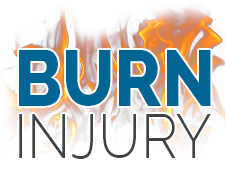Burn Injury Infection
Burn injury infection is among the most serious complications of a burn injury. Burn patients are susceptible to burn injury infections due to the exposure of underlying tissue in a burn area. The skin acts as a natural barrier to bacteria. When the skin is damaged or dead, it fails to provide this protection. Burn patients with minor burns should take special care to sterilize and cover burns. In severe cases such as second, third, and fourth degree burns, treatment center specialists will protect the wounds and administer antibiotics to prevent burn injury infection.
Types of Burn Injury Infections
A burn injury infection may occur in several forms. The most common type of burn injury infection occurs at the site of the wound upon the introduction of bacteria or fungus. Other types of infection are associated with burns, such as pneumonia and urinary tract infections.
Pneumonia
Pneumonia is the infection of the lungs and lower airways. Pneumonia is most common in burn patients who experience smoke inhalation injury from a fire. Smoke inhalation injury affects the airways and lungs. However, pneumonia may also occur in patients without smoke inhalation injury.
Signs and Symptoms
Signs and symptoms of burn injury infection include the following:
- Fever
- Increased pain and swelling
- Foul-smelling pus or greenish discharge
- Purplish, dark brown or black discoloration of the burn injury
- A second-degree burn which develops into full necrosis, or tissue death
- Change in the thickness of the burn wound
Burn Injury Infection Risk Factors
Studies show that patients with certain underlying medical conditions may be more susceptible to burn injury infection. AIDS patients may experience more difficulty with wound healing, which increases the risk of burn injury infection. Diabetes patients may also be more susceptible to delayed healing time and burn injury infection, especially when the burn area includes extremities such as arms and legs.
Sepsis from Infection
Sepsis is a life-threatening complication of burn injury infection. During sepsis, bodily inflammation occurs as a reaction to the natural chemicals that are released to fight infection. As a result, the patient may experience decreased blood flow to vital organs. In severe cases, the patient may enter septic shock, which may lead to a significant blood pressure drop, organ failure, and death. The journal Clinical Microbiology Reviews states that in patients whose burns cover 40 percent or more of the total body surface area (TBSA), roughly 75 percent of deaths are related to sepsis from infection of the burn injury.
Sources:
Bhat, Satyanarayan, and Stephen Milner. “Antimicrobial Peptides in Burns and Wounds.” Current Protein & Peptide Science 8.5 (2007): 506-520. MEDLINE with Full Text. Web. 19 Dec. 2013.
“Burn injury/HIV infection/sepsis independently result in immunosuppression.” Health & Medicine Week 17 Jan. 2005: 120. Academic OneFile. Web. 19 Dec. 2013.
Dries, David J. “Management of burn injuries – recent developments in resuscitation, infection control and outcomes research.” Scandinavian Journal of Trauma, Resuscitation and Emergency Medicine 17 (2009): 14. Academic OneFile. Web. 19 Dec. 2013.
Rowley-Conwy, Gabby. “Infection prevention and treatment in patients with major burn injuries.” Nursing Standard 25.7 (2010): 51+. Academic OneFile. Web. 19 Dec. 2013.













